
Green Ghost is a board game for up to 4 players, first published in 1965 by Transogram. [1] Green Ghost is the first board game designed to be played in the dark.[ citation needed ]

Green Ghost is a board game for up to 4 players, first published in 1965 by Transogram. [1] Green Ghost is the first board game designed to be played in the dark.[ citation needed ]
Transogram mass-produced the game in 1965, [2] then sold its toy interests to Marx Toys in 1970. In Australia, the game was distributed by the Ideal Toy Company.
In 1997 Marx Toys produced a 30th Anniversary edition of the game (MCMXCVII, Item #3905). This box has "Find Kelly the Ghost... if you DARE" printed on it.
Green Ghost remains collectible, [3] but with so many different editions it is difficult for collectors to know if they have a complete set. [4]
Original television commercials for the game encouraged players to play it in the dark. [5] The 1965 box has the printed strapline "THE EXCITING GAME OF MYSTERY THAT GLOWS IN THE DARK."
The central character in the game was modeled on The Blob and the design was aimed at the campy horror genre of shows like The Addams Family. [7]

The three-dimensional board features standing scenery and is designed to appear as a spooky town with winding paths surrounding three scenes. The luminous plastic board is elevated on six stilts and underneath are three boxes, covered by locked trapdoors, representing pits which contain either plastic bones, "bat" feathers or rubber snakes, plus a number of hidden "ghost kids" (one of which is "Kelly", the Green Ghost's child). [8] Several paths wind around the three pits, consisting of regular spaces, spaces with pictures of a "pet" (player pawn), and holes to access the pits. [6]
For the initial setup, four ghost kids are placed in each pit. The other pit items are placed in each pit to provide texture when a player reaches into a pit to retrieve a ghost kid: [6]
Each player selects one pawn: vulture, rat, cat, or bat. The keys are mixed up and hidden under the board, and each player draws one key at random. Players use the trapdoor keys to collect ghost kids and increase their chances of winning. For games with fewer than four players, the remaining keys are kept under the board. Each player places their pawn on any regular (non-pawn picture) space. The youngest player starts the game. [6]
On each turn, the player spins the large Green Ghost to determine the number of spaces they can move. Players may move in any direction from the space they currently occupy. [6]
If a player (Player A) lands on a space with a picture of the pawn used by another player (Player B), Players A and B may exchange their keys. Player A also has the option to not exchange keys, but if Player A requests a key exchange, Player B must comply. Because there are four keys and three locked pits, one of the keys is a "misfit" which does not open any pit. [6]
If a player lands on a hole, they "vanish" and "reappear" at the pit corresponding to the key they hold. They must use the key to unlock that pit, reach inside, and retrieve one ghost kid. Immediately after retrieving the ghost kid, they place their pawn on any space with a picture of a pawn, and are then required to exchange keys. [6]
When all twelve ghost kids have been retrieved from the traps, they are placed in little holes on the Green Ghost spinner (players need to remember which ghost kids are found). Then the player who collected the fewest ghost kids spins the large Green Ghost one more time, pointing to the little ghost it identifies as Kelly. Whoever found the one pointed to wins the game. [6]
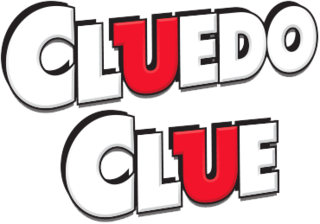
Cluedo, known as Clue in North America, is a murder mystery game for three to six players that was devised in 1943 by British board game designer Anthony E. Pratt. The game was first manufactured by Waddingtons in the United Kingdom in 1949. Since then, it has been relaunched and updated several times, and it is currently owned and published by the American game and toy company Hasbro.
Chess strategy is the aspect of chess play concerned with evaluation of chess positions and setting goals and long-term plans for future play. While evaluating a position strategically, a player must take into account such factors as the relative value of the pieces on the board, pawn structure, king safety, position of pieces, and control of key squares and groups of squares. Chess strategy is distinguished from chess tactics, which is the aspect of play concerned with the move-by-move setting up of threats and defenses. Some authors distinguish static strategic imbalances, which tend to persist for many moves, from dynamic imbalances, which are temporary. This distinction affects the immediacy with which a sought-after plan should take effect. Until players reach the skill level of "master", chess tactics tend to ultimately decide the outcomes of games more often than strategy. Many chess coaches thus emphasize the study of tactics as the most efficient way to improve one's results in serious chess play.

Twister is a game of physical skill produced by Milton Bradley Company and Winning Moves Games USA. It is played on a large plastic mat that is spread on the floor or ground. The mat has four rows of six large colored circles on it with a different color in each row: red, yellow, green and blue. A spinner tells players where they have to place their hand or foot. The game promotes itself as "the game that ties you up in knots".
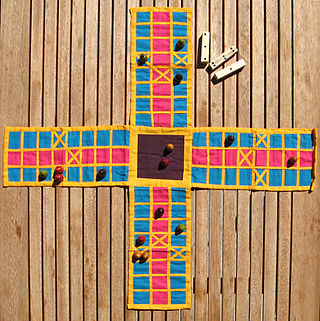
Pachisi is a cross and circle board game that originated in Ancient India. It is described in the ancient text Mahabharata under the name of "Pasha". It is played on a board shaped like a symmetrical cross. A player's pieces move around the board based upon a throw of six or seven cowrie shells, with the number of shells resting with the aperture upward indicating the number of spaces to move.

Candy Land is a simple racing board game created by Eleanor Abbott and published by Milton Bradley in 1949. The game requires no reading and minimal counting skills, making it suitable for young children. No strategy is involved as players are never required to make choices; only following directions is required. Over 50 million copies of Candy Land have been sold.

Sorry! is a board game that is based, like the older game Ludo, on the ancient Indian cross and circle game Pachisi. Players move their three or four pieces around the board, attempting to get all of their pieces "home" before any other player. Originally manufactured by W.H. Storey & Co in England and now by Hasbro, Sorry! is marketed for two to four players, ages 6 and up. The game title comes from the many ways in which a player can negate the progress of another, while issuing an apologetic "Sorry!"

Quoridor is a two- or four-player intuitive strategy game designed by Mirko Marchesi and published by Gigamic Games. Quoridor received the Mensa Mind Game award in 1997 and the Game Of The Year in the United States, France, Canada and Belgium.

Louis Marx and Company was an American toy manufacturer in business from 1919 to 1980. They made many types of toys including tin toys, toy soldiers, toy guns, action figures, dolls, toy cars and model trains. Some of their notable toys are Rock'em Sock'em Robots, Big Wheel tricycles, Disney branded dollhouses and playsets based on TV shows like Gunsmoke. Its products were often imprinted with the slogan "One of the many Marx toys, have you all of them?"
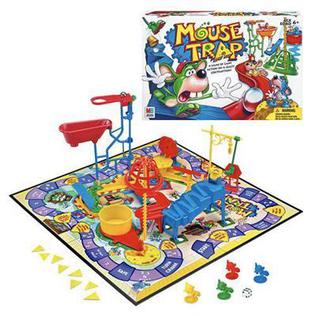
Mouse Trap is a board game first published by Ideal in 1963 for two to four players. It is one of the first mass-produced three-dimensional board games. Players at first cooperate to build a working mouse trap in the style of a Rube Goldberg machine. Then, players turn against each other to trap opponents' mouse-shaped game pieces.
Rock 'Em Sock 'Em Robots is a two-player action toy and game designed by Marvin Glass and Associates and was first manufactured by the Marx toy company in 1964. It features two dueling robot boxers, Red Rocker and Blue Bomber, mechanically manipulated by the players, and the game is won when one player knocks the opposing robot's head up and off the shoulders. The 2000s version of the game by Mattel features physically smaller robots.

Wild & Crazy Kids is an American television game show in which large teams, usually consisting entirely of children, participated in head-to-head physical challenges on Nickelodeon. The show lasted for three seasons from 1990 until 1992 for a total of 65 episodes. Wild & Crazy Kids starred three teenage co-hosts Omar Gooding and Donnie Jeffcoat in all three seasons, accompanied by Annette Chavez in season 1 and Jessica Gaynes for the last two seasons.
The long-running British science fiction television series Doctor Who has since its beginnings in 1963 generated many hundreds of products related to the show, from toys and games to picture cards and postage stamps. This article is not an exhaustive list of merchandise but attempts to present a flavour of the type of material that has been produced. This entry mainly concentrates on "official" spin-offs, that is to say, material sanctioned by the British Broadcasting Corporation, which produces the series.

Mr. Bucket is a tabletop game and toy published by Milton Bradley and released in 1991, which was discontinued but re-released in 2007. It was discontinued again and re-released again in 2017. The game features a plastic, motorized bucket which ejects differently-colored balls from its mouth. The players use plastic shovels to scoop up the balls and place them back inside Mr. Bucket.

Ka-Bala was a talking board game manufactured and released by Transogram in 1967. It was marketed under the slogan, "The Mysterious Game that Tells the Future."
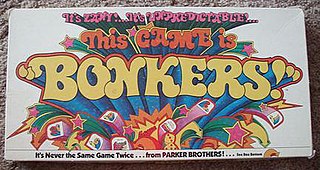
Bonkers! is a race-style board game designed by Paul J. Gruen and produced first by Parker Brothers, later by Milton Bradley, and briefly reissued by Winning Moves. The object is to be the first player to score 12 points by adding instruction cards to the empty spaces in an attempt to move to several scoring stations. The game's slogan is "It's Never the Same Game Twice!"

Topper Corporation was a United States toy and board game manufacturer based in Elizabeth, New Jersey. The company, founded and run by Henry Orenstein, a holocaust survivor, produced toys under several brand names including: Johnny Lightning, Johnny Seven OMA, Dawn doll, and Suzy Homemaker.

Mall Madness is a shopping themed board game released by Milton Bradley in 1988.
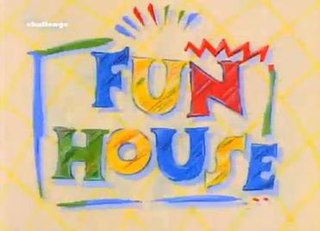
Fun House is a British children's game show, based on the American show of the same name, that aired on ITV from 24 February 1989 to 29 December 1999. It was hosted by Pat Sharp, who was also aided by twin cheerleaders Melanie and Martina Grant. The announcer was Gary King. The theme tune was composed by David Pringle and Bob Heatlie. In 2000, it was revealed by the BBC programme TV's Finest Failures that a spin-off of Fun House featuring adult contestants was also planned. A pilot was produced, which included Carol Smillie as a contestant, but it was ultimately never broadcast.
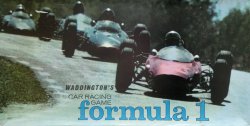
Formula 1 is a motor racing themed board game designed by John Howarth and Trevor Jones and originally published by Waddingtons of Leeds, United Kingdom in 1962.
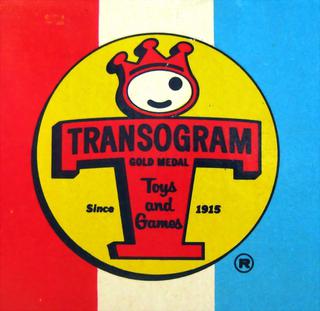
Transogram was an American producer of toys, games and other leisure products from the early 20th century to 1971. It is best known for such long-produced games as Tiddledy Winks and Game of India, as well as such baby-boomer favorites as Green Ghost and television tie-in board games for such characters and series as Atom Ant, The Flintstones, Gomer Pyle, U.S.M.C., Perry Mason and Tom and Jerry.